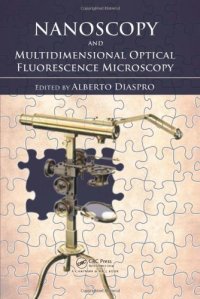
Ebook: Nanoscopy and Multidimensional Optical Fluorescence Microscopy
Author: Alberto Diaspro
- Year: 2010
- Publisher: Chapman and Hall/CRC
- Edition: 1
- Language: English
- pdf
"Alberto Diaspro has been choreographing light’s dance for over 20 years, and in Nanoscopy and Multidimensional Optical Fluorescence Microscopy, he has assembled a diverse group of experts to explain the methods they use to coax light to reveal biology’s secrets."— From the Foreword by Daniel Evanko, editor, Nature Methods Nanoscopy and Multidimensional Optical Fluorescence Microscopy demonstrates that the boundaries between sciences do blur at the bottom, especially those that might separate the optical work of physicists and the cellular work of microbiologists. In 18 chapters written by pioneering researchers, this work offers the first comprehensive and current documentation of the cutting-edge research being accomplished in a wide range of photonic devices with revolutionary application. The highlight of the book is its coverage of optical nanoscopy and super-resolution microscopy. The rapid advances in this area over the past few years offer researchers in both photonics and molecular biologya wealth of accomplishment upon which they can build. Offering a complete treatment of this emerging field, this volume: Describes how scientists have exploited the properties of light and its fluorophore partners to overcome the resolution limit of conventional light microscopy Delves into recent ways to minimize the photobleaching that has long hampered many methods including those that have the potential to capture previously unobtainable information on the movements of single molecules Discusses the principles, benefits, and implementation of fluorescence correlation spectroscopy and related methods, which simplifies analysis by limiting light to stationary focal points in a sample Considers the most basic as well as emerging methods for improving three-dimensional optical sectioning microscopy Reviews the basics of FRET (fluorescence resonance energy transfer) and considers its new use for investigating protein complexes The text also introduces those emerging nonfluorescence microscopy methods that can actually exert mechanical forces to trap and move a variety of objects ranging from beads to living cells and cellular organelles. Combining this technique with fluorescence microscopy provides an unparalleled ability to manipulate and visualize biological samples. In the half-century since Richard Feynman challenged scientists to come up with the tools to investigate and manipulate our world at the nanoscale, we have succeeded in placing tools in the hands of biophysicists that are leading to major breakthroughs in our understanding of life and our ability to diagnose, treat, and prevent many challenges to human health. This book reflects what has been accomplished to date while pointing the way to what still needs to be done.
Download the book Nanoscopy and Multidimensional Optical Fluorescence Microscopy for free or read online
Continue reading on any device:

Last viewed books
Related books
{related-news}
Comments (0)